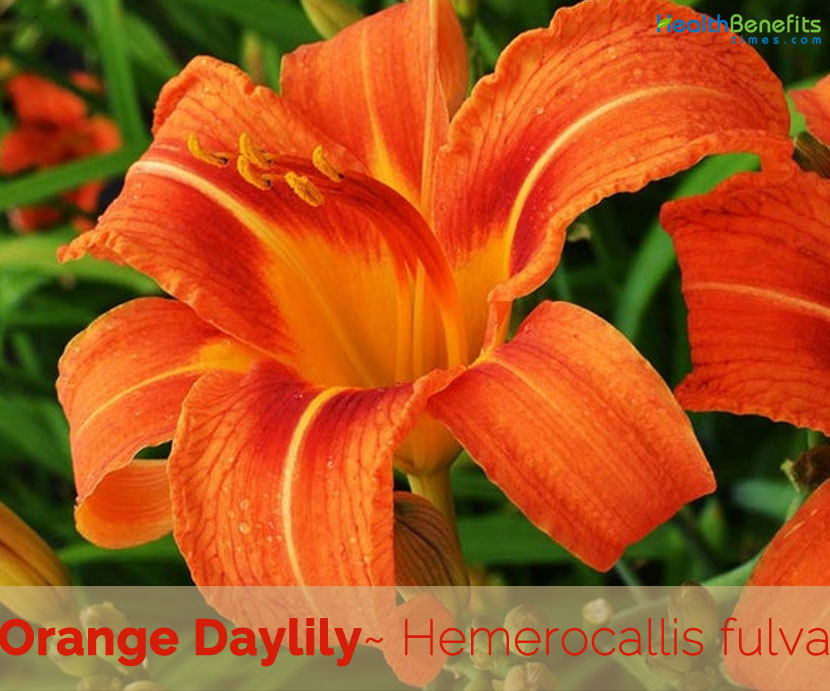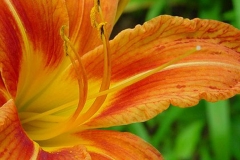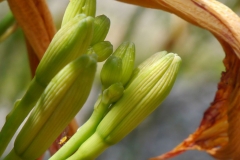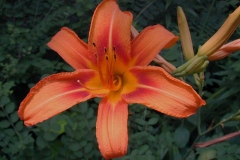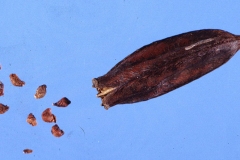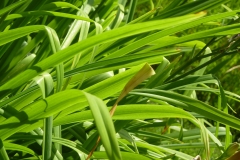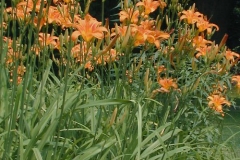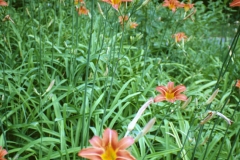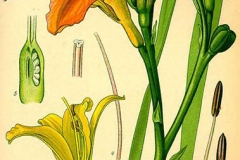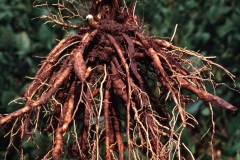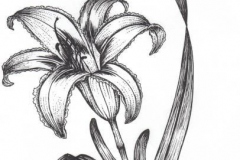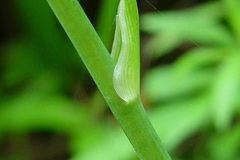| Orange Daylily Quick Facts | |
|---|---|
| Name: | Orange Daylily |
| Scientific Name: | Hemerocallis fulva |
| Origin | East Asia—China |
| Shapes | Capsule ellipsoid, 3-valved, 2–2.5 cm long and 1.2–1.5 cm wide |
| Health benefits | Beneficial for cancer, oppilation, jaundice, constipation, pneumonia, common colds, cough, edema and treat irregular or abnormal menstruation |
| Name | Orange Daylily |
|---|---|
| Scientific Name | Hemerocallis fulva |
| Native | East Asia—China (Anhui, Fujian, Guangdong, Guangxi, Guizhou, Hebei, Henan, Hubei, Hunan, Jiangsu, Jiangxi, Shaanxi, Shandong, Shanxi, Sichuan, Taiwan, Xizang, Yunnan, Zhejiang) |
| Common Names | Coastal Day Lily, Common Yellow Day Lily, Ditch Daylily, Fulvous Daylily, Orange Daylily, Tawny Daylily, Tiger Daylily, Common Day Lily, Double Daylily, fulvous daylily, ditch lily, railroad daylily, roadside daylily, outhouse lily, wash-house lily |
| Name in Other Languages | Arabic: zanabaq alnahar alkahramanii (زنبق النهار الكهرماني) Armenian: Voskeghenik gorshakarmir (Ոսկեղենիկ գորշակարմիր) Austria: Gelbrote Taglilie Azerbaijani: Kürən günotu Bulgarian: Zhŭltokafyav krin (жълтокафяв крин) Catalan: Assutzena rossa, Flor d’un dia, Hemerocal·lis, Lliri de sant antoni, Lliri de sant joan, Lliri d’un dia, Lliri groc, Lliris naronjats Chinese : Xuan Cao (萱草), Chang Ban Xuan Cao, Chang Guan Xuan Cao, Chang Lu Xuan Cao, Croatian: Crvenožuta graničica Czech : Denivka Forrestova, Denivka Plavá Danish : Brun Daglilje, Rødgul Daglije, Rødgul Daglilje Dutch : Bruine Daglelie English: Orange Day-lily, Fulvous day-lily, Tawny day-lily, Common orange daylily, dark day lily Estonian : Ruuge Päevaliilia Finnish : Punakeltainen Päivänlilja, Rusopäivänlilja French : Hémérocalle Fauve, Lis rouge, Lis d’un jour, hémérocalle jaune German : Bahnwärter-Taglilie, Braunrote Taglilie, Gelbrote Taglilie, Rotgelbe Taglilie Hungarian: Lángszínű sásliliom, Tuzliliom India : Swarnlili Italian : Giglio Di San Giuseppe, emerocallide fulva, giglio dorato Japanese : Akino-Wasuregusa, Hama-Kanzō, Oni-Kanzo, Yabu-Kanzo, Wasuregusa (ワスレグサ), Kanzo (カンゾ) Korean : Heutowanchuri, Khnwonchuri, Nomnamul, Wangwonchuli, Wonch’uri Latvian: Rusvoji viendiene Lithuanian: Rusvoji viendienė Norwegian : Brun Daglilje Persian: زنبق رشتی Polish : Liliowiec Rdzawy Russian : Krasodnev Buro-Želtyj, Krasodnev Ryžij, Lileynik oranzhevyy (Лилейник оранжевый), lileynik ryzhiy (лилейник рыжий) Serbian: Ljiljan (љиљан) Slovak: Laliovka červenkastá Slovašcina : Maslenica Rumenorjava, Rumenorjava Maslenica Slovencina : Ľaliovka Žltá Swedish : Branddaglilja, Brunröd Daglilja Thai : DtôN-Jam-Chàai Turkish: Turuncu güngüzeli, güngüzeli Ukrainian: Liliynyk ruduvatyy (лілійник рудуватий) Vietnamese : Hoa Hiên, Huyên Thảo, Hoàng Hoa, Kim Trâm Thái, Lộc Thông |
| Plant Growth Habit | Herbaceous clump-forming perennial deciduous plant |
| Growing Climates | forests, thickets, grasslands, stream-sides, meadows, floodplains, ditches, forest edges, cemeteries and cemetery prairies, woodland borders, areas along railroads and roadsides, sites of abandoned homesteads, and old flower gardens |
| Plant Size | 2 to 4 ft. (0.6 to 1.2 m) tall |
| Root | Plant develops rhizomes (horizontal underground stems) and fleshy, tuberous, spindle-shaped roots, with thinner, fibrous roots growing from both to form a dense system |
| Stem | Smooth, round, leafless and branched at the top |
| Leaf | Long, linear, strap-like, bright-green, 50–90 cm long and 1–2.8 cm broad and curve toward the ground |
| Flowering season | June to August |
| Flower | Flowers are large, showy, orange, usually with some striping; occur in clusters of 5-9 at the tip of the stalk; flowers in a cluster open one at a time, each for one day only; summer. |
| Fruit Shape & Size | Capsule ellipsoid, 3-valved, 2–2.5 cm long and 1.2–1.5 cm wide dehisces at maturity to release the seeds |
Plant description
Orange Daylily is an herbaceous clump-forming perennial deciduous plant that normally grows about 2 to 4 ft. (0.6 to 1.2 m) tall with fleshy globose-ellipsoid, swollen, tuberous part near tip and stolon. The plant is found growing in forests, thickets, grasslands, stream-sides, meadows, floodplains, ditches, forest edges, cemeteries and cemetery prairies, woodland borders, areas along railroads and roadsides, sites of abandoned homesteads, and old flower gardens. The plant develops rhizomes (horizontal underground stems) and fleshy, tuberous, spindle-shaped roots, with thinner, fibrous roots growing from both to form a dense system. Stems are smooth, round, leafless and branched at the top, growing 2 to 4 feet tall (sometimes up to 6 feet). A few small, leaf-like bracts may develop in the upper portion of the stem.
Leaves
Sword-like leaves are arranged in pairs and grow only at the base of the plant. The leaves are 50–90 cm long and 1–2.8 cm broad, narrow, smooth and slightly folded, with a central ridge running lengthwise down the back of the leaf. There are no leaves on the scape, but there may be several small leafy bracts.
Flower
The inflorescence is terminal cluster of long stalked flowers (a cyme) atop the scape. The cluster can produce as many as 10 to 20 flowers, but only one open at a time. Branching occurs within the inflorescence, not below on the scape. Flowers are orange and quite large, spanning individually about 3½ inches across. They are held semi-erect or horizontally on the stalks, rather than hanging downward. Each flower consists of 6 orange tepals (3 petals and 3 sepals that are similar in appearance) that are united at the base, but spread outward and backward toward their tips. The 3 inner tepals are somewhat broader than the 3 outer tepals. The margins of each tepal are rolled. The throat of the flower is yellow, around which there is a band of red, while the remainder of the flower is some shade of orange. Exerted from its center, there are 6 long stamens and a single style. Buds of the flowers are green to greenish orange, oblong, and up to 3 inches long. The blooming period occurs between June to August and lasts about a month. Each flower lasts only a single day, hence the common name.
Fruit
Fertile flowers are followed by 3-lobed cylindrical capsule seed consists of rows of black seeds. However, these seeds are infertile because the Orange Day Lily is a sterile hybrid. This plant often forms vegetative clumps of plants that exclude other species.
Traditional uses and benefits of Orange Daylily
- Plant has diuretic, febrifuge, laxative properties.
- Flowers are anodyne, antiemetic, antispasmodic, depurative, febrifuge and sedative.
- Flower extract is used as blood purifier and as an anodyne for women in childbirth in China.
- Tea made from boiled rhizomes is used as a diuretic.
- Rhizome has a folk history of use in the treatment of cancer.
- Juice from the rhizome is used as an antidote in cases of arsenic poisoning.
- In Korea, the rhizome is used to treat oppilation, jaundice, constipation and pneumonia and has antimicrobial, tuberculostatic and anthelmintic activity against parasitic worms that cause filariasis.
- They are used as an anodyne for women in childbirth in China.
- An extract of the flowers is used as a blood purifier.
- Rhizome has shown antimicrobial activity, it is also tuberculostatic and has an action against the parasitic worms that cause filariasis.
- Juice of the roots is an effective antidote in cases of arsenic poisoning.
- Root also has a folk history of use in the treatment of cancer – extracts from the roots have shown anti-tumor activity.
- Decoction of Orange Daylily root and wine is taken to treat common colds as well as coughing in infants and children.
- Powdered Orange Daylily root and leaves are taken before meal to treat edema (swelling caused by fluid retention).
- Orange Daylily root juice mixed with fresh ginger juice is taken to treat bleeding from five sense organs or subcutaneous tissue.
- Decoction of Orange Daylily root is taken daily to treat difficulty in passing urine.
- Orange Daylily root and fresh ginger (fried) are pounded and taken with wine to treat blood in stool.
- Decoction of Orange Daylily root can also be used in treating irregular or abnormal menstruation.
Culinary Uses
- Dried flowers are used as spice and root tubers, young leaves and young shoots and flower buds are eaten as vegetable.
- Thick petals can be eaten raw.
- The flowers can also be dried and used as a thickener in soups or as relish.
- Tuber especially the young tubers are eaten cooked.
- Leaves and young shoots can be consumed after being cooked.
- It is considered as an asparagus or celery substitute.
- Leaves need to be eaten whilst still very young since they quickly become fibrous.
- Flowers can be consumed raw or cooked.
- Petals are thick and crunchy, making very pleasant eating raw, with a nice sweetness at the base because of the nectar.
- In this case, they are picked when somewhat withered and closed.
- Flower buds can be consumed raw or cooked and has a pea-like flavor.
- It can be dried and used as a relish.
- Tubers can be consumed raw or cooked and has nutty flavor.
- Young tubers are best, though the central portion of older tubers is also good.
Other facts
- The plant is widely grown as an ornamental plant and is used in soil erosion control.
- Tough dried foliage is plaited into cord and used for making footwear.
- Plants form a spreading clump and are suitable for ground cover when spaced about 90 cm apart each way.
- Dead leaves should be left on the ground in the winter to ensure effective cover.
- The cultivar ‘Kwanso Flore Pleno’ has been especially mentioned.
- They can prevent soil erosion if planted in slopes.
- This tremendously beautiful flower finds admiration amidst floral bouquets and flower vases.
- In a common local omen culture expecting women are asked to wear daylilies around their waist in order to give birth to a male child.
- This herb has many cultivars and their sub-cultivars, all of which count up to more than 1000 in number.
- Some cultivars of this edible flower are poisonous.
Precautions
- Large quantities of the leaves are said to be hallucinogenic.
- Blanching the leaves removes this hallucinatory component.
- These plant leaves are known to contain hallucinogenic properties.
- If anyone is allergic to the any of the nutrients that these herbs contain, then the person should consult experts’ opinions on this herb’s consumption.
- Over consumption of anything can be harmful anyway. Daylilies are no exception to this norm.
References:
https://www.itis.gov/servlet/SingleRpt/SingleRpt?search_topic=TSN&search_value=42943#null
https://pfaf.org/user/plant.aspx?LatinName=Hemerocallis+fulva
https://www.cabi.org/isc/datasheet/114743
http://www.missouribotanicalgarden.org/PlantFinder/PlantFinderDetails.aspx?kempercode=k430
http://www.floracatalana.net/hemerocallis-fulva-l-l-
https://invasive-species.extension.org/hemerocallis-fulva-orange-daylily/
https://davesgarden.com/guides/pf/go/201/#b
http://www.narc.gov.jo/gringlobal/taxonomydetail.aspx?id=409647
https://plants.usda.gov/core/profile?symbol=HEFU
https://en.wikipedia.org/wiki/Hemerocallis_fulva
https://npgsweb.ars-grin.gov/gringlobal/taxonomydetail.aspx?18861
https://www.invasiveplantatlas.org/subject.html?sub=3407
https://gd.eppo.int/taxon/HEGFU
http://www.theplantlist.org/tpl1.1/record/kew-277643
http://www.plantsoftheworldonline.org/taxon/urn:lsid:ipni.org:names:536335-1
https://bie.ala.org.au/species/https://id.biodiversity.org.au/node/apni/2903652
https://indiabiodiversity.org/species/show/229899
http://www.flowersofindia.net/catalog/slides/Orange%20Daylily.html


